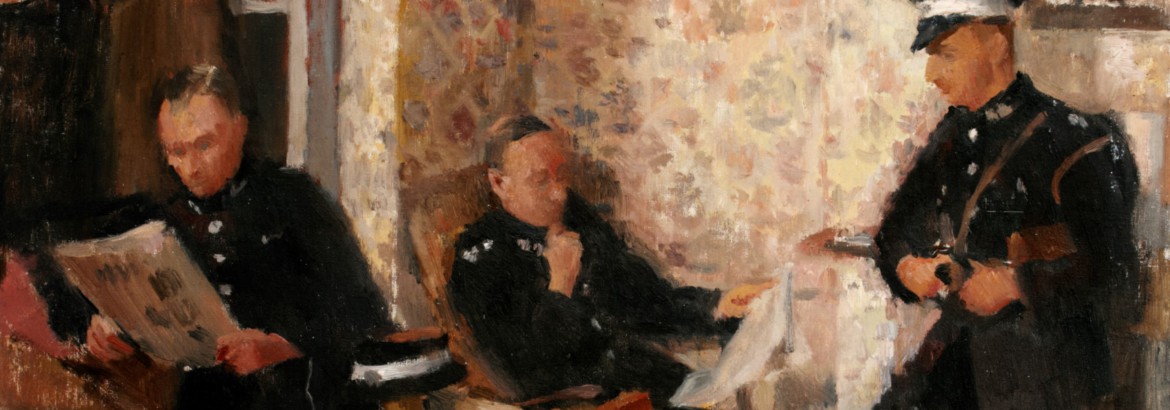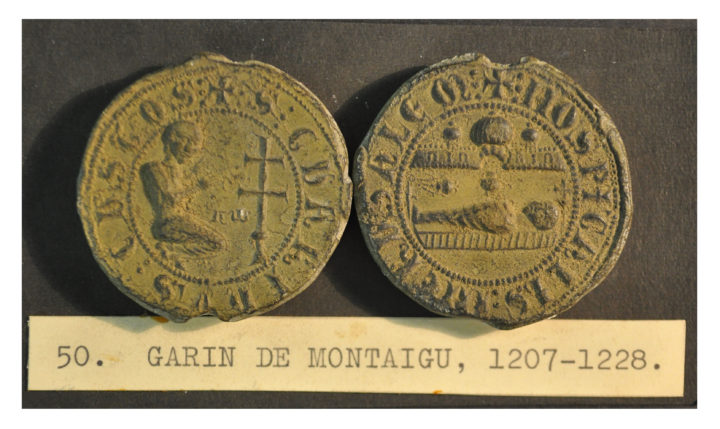This bulla, which looks rather like a large coin, is in fact a seal which would have been attached to a document as a form of attestation, much like we use signatures today. In the late nineteenth or early twentieth century this lead bulla was found during archaeological digs near a church in Apulia, southern Italy. It dates from six hundred years before that and is the seal of Garin de Montaigu, the Grand Master of the Order of St John from 1207 to 1228, when the Order was running a large hospital in Acre in modern-day Israel.
In the heat of the Mediterranean wax seals would have been likely to soften and break and so seals were often made of lead instead and were known as bullae. It was customary to attach such seals with a cord so that they would hang down from the document. The bullae of Grand Masters, such as this one, are known as great seals and have two faces, an obverse and a reverse.
On the obverse of this seal, the Master of the Hospital is depicted facing right, kneeling in prayer before the patriarchal cross, a symbol of Christianity. Next to the cross are marked the letters alpha and omega, the first and last letters of the Greek alphabet and symbols of the eternity of Christ and God. There is an inscription around the outside which is written in Latin, as was customary at the time. It reads GUARINVS:CVSTOS: Guarinus is the Latin form of the name Garin while Custos is the Latin root of our English word ‘custodian’ and was used on all great seals to describe the role of the Grand Master.
On the reverse of this seal is the body of a dead man on a mattress or a bier (a movable frame on which a coffin or a corpse is placed before burial or cremation). He is wrapped in swathing bands (narrow strips of cloth) with a cross at his head. He is lying beneath an architectural feature formed of three domes. There is a lamp hanging from the middle one and a censer (an incense burner) is swinging over the dead man’s feet. The inscription on this side of the bulla, also in Latin, reads HOSPITALIS:IHERVSALEM: Jerusalem Hospital. Jerusalem was the location of the Order’s first hospital, where they cared for pilgrims who had come to visit the Church of the Holy Sepulchre in Jerusalem, the site at which Christ is believed to have been crucified and buried, and to have risen.
One theory is that the architectural feature depicted on the seal is in fact the Church of the Holy Sepulchre. This is a topic of some debate, but there is certainly a striking similarity between the designs of the great seals and the designs of some ampullae (flasks) also from the same period, including one that is now in the British Museum’s collection. These ampullae show the Church of the Holy Sepulchre, with the three towers it had at the time, and with the body of Christ shown wrapped in a burial shroud beneath the central dome, therefore making a connection between the 1st-century burial of Christ and the 12th-century reality of the. The images on the great seals could also be interpreted as showing Christ’s dead body in the Church of the Holy Sepulchre, or they could simply show a patient in the Order’s hospital. In fact, this ambiguity could be deliberate in order to connect the central goal of Jerusalem pilgrims to the charitable activities of the Hospitallers who provided for their welfare.
This blog post has been greatly informed by the Bearers of the Cross research project and more information about this bulla can be found on their website: http://www.bearersofthecross.org.uk/collections/getrecord/LDOSJ_1601
Listen to Dr William Purkis’ lecture in which he discusses the images depicted on the reverse of the seal: http://www.bearersofthecross.org.uk/bearers-cross-tv/
For more information about the ampulla whose design resembles the seal: http://www.britishmuseum.org/research/collection_online/collection_object_details.aspx?objectId=59492&partId=1&searchText=1876,1214.18&page=1



